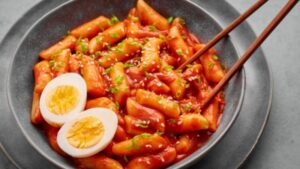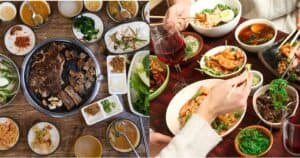Are you curious about the distinct flavors and cooking styles of Korean and Filipino cuisines? Wondering how these two culinary traditions differ from each other? Look no further!
In this blog post, we will delve into the unique characteristics of Korean and Filipino food, taking a closer look at their ingredients, flavors, influences, and staple dishes. Get ready for a mouthwatering journey that will surely satisfy your culinary curiosity.
Key Ingredients and Flavors
Fermented Pastes:
– Korean cuisine uses fermented pastes like gochujang and doenjang, which add a unique umami flavor to dishes.
– Filipino cuisine also utilizes fermented ingredients like buro and miso, although they may not be as commonly used as in Korean cuisine.
Health Focus vs Cholesterol-rich Foods:
– Korean cuisine focuses on maintaining a healthy body through the food that they eat. They prioritize fresh ingredients, lean meats, and balanced meals.
– In contrast, Filipino cuisine tends to include heartier foods that are rich in cholesterol. Ingredients like pork, beef, and coconut milk are commonly used and contribute to the richness of the dishes.
Korean BBQ and Condiments:
– Korean BBQ is known for its inclusiveness, offering a variety of condiments, side dishes, and types of meat or main courses. These condiments, such as kimchi, garlic, and ssamjang, add different flavors and textures to the meal.
– Filipino cuisine also loves grilled meats, but the condiments and flavors differ. Popular Filipino condiments include soy sauce, vinegar, and various dipping sauces, which complement the grilled meats with a tangy and savory taste.
Cooking Styles and Techniques
Korean cuisine and Filipino cuisine have distinct cooking styles and techniques that make each of them unique. Here are some differences:
Korean Cuisine:
- Korean cuisine is focused on using rice, vegetables, seafood, and meats as its main ingredients.
- Traditional Korean meals are often accompanied by banchan, a variety of side dishes served with steam-cooked short-grain rice.
- Fermentation is a common technique in Korean cuisine, leading to the creation of fermented pastes like gochujang and doenjang.
- Grilling and barbecuing, such as the popular Korean BBQ, are commonly used cooking methods in Korean cuisine.
Filipino Cuisine:
- Filipino cuisine is known for its hearty and rich dishes.
- Rice is a staple in Filipino cuisine and is frequently served alongside various dishes.
- Filipino cuisine has a mix of culinary influences from Spanish, Chinese, and Malay cultures.
- Fermented ingredients like buro and miso are used in Filipino cuisine.
- Filipino cooking techniques include boiling, stewing, frying, and grilling.
Both Korean and Filipino cuisines offer a diverse range of delicious dishes, each with its own unique flavors and culinary traditions. While Korean cuisine focuses on rice, vegetables, and seafood with a strong emphasis on fermentation and grilling, Filipino cuisine is known for hearty foods with a mix of cultural influences and a variety of cooking techniques. Despite these differences, both cuisines are highly flavorful and beloved by food enthusiasts worldwide.
Influences and Cultural Background
The cultural background and influences on Korean and Filipino food are both unique and diverse. While Korean cuisine has gained significant popularity in the Philippines, Filipino cuisine also showcases its own distinct cultural influences.
Korean cuisine:
- Korean culture has made a breakthrough in the Philippines, especially in the early 2000s, with the rise of Korean entertainment like K-Pop and Korean dramas.
- Korean foods, such as kimchi and other Korean dishes, have become popular among Filipinos, who have embraced cooking and enjoying them.
- Korean restaurants have been established in different parts of the Philippines, offering a variety of authentic Korean dishes.
- Korean noodle dishes, particularly Samyang, have gained popularity and are even sold as instant noodles in the Philippines.
Filipino cuisine:
- Filipino cuisine is influenced by various cultures, including Spanish, Chinese, and Malay influences.
- Filipinos have developed a love for Korean culture, including Korean food, K-Pop, and K-Dramas.
- Korean foods and products have become evident in the Philippine market, with the rise of Korean stores, restaurants, and the availability of K-beauty products, clothes, and food products.
- Popular Korean foods, such as samgyeopsal, gimbap, kimchi, and chapchae, have been embraced and loved by Filipinos.
Staple Dishes and Meal Presentation
The staple dishes and meal presentation in Korean and Filipino food have some notable differences. Here’s a breakdown:
Korean Cuisine:
- Rice is a staple in Korean cuisine and is often served alongside various dishes.
- Traditional Korean meals are named according to the number of side dishes (banchan) accompanying steam-cooked short-grain rice.
- Kimchi, a fermented vegetable dish, is served at nearly every meal in Korean cuisine.
- Korean BBQ is a popular dining style where diners grill their own meat at the table and enjoy it with various condiments and side dishes.
Filipino Cuisine:
- Rice is also a staple in Filipino cuisine and is typically served with meat, fish, and vegetable dishes.
- Filipino meals often consist of a main protein dish, such as adobo or sinigang, served with rice and various side dishes.
- Filipino cuisine incorporates a variety of dishes influenced by different regions and ethnic groups, resulting in a diverse range of flavors and presentations.
- Filipino meals may include merienda, which refers to snacks or light meals enjoyed between main meals.
Regional Variations and Specialty Dishes
Korean cuisine has a strong focus on rice, vegetables, seafood, and meats. It has evolved over centuries, reflecting the natural environment and cultural trends. One popular dining style in Korean cuisine is Korean BBQ, where diners grill their own meat at the table and enjoy it with various condiments and side dishes. Some well-known Korean dishes include bibimbap, bulgogi, japchae, kimchi, and kimbap.
On the other hand, Filipino cuisine incorporates influences from various cultures, such as Spanish, Chinese, and Malay. Some popular Filipino dishes include adobo, sinigang, lechon, pancit, and lumpia. Filipino cuisine is known for its use of vinegar, soy sauce, and other strong flavors. Merienda, or snacks, are an important part of Filipino cuisine.
Now, let’s take a closer look at the regional variations and specialty dishes in each cuisine:
Korean cuisine showcases regional variations in its dishes. For example:
- Jeolla province in Korea is famous for its seafood dishes like raw fish and seafood stews.
- Gangwon province is known for its mountainous terrain, and dishes from this region often feature locally grown vegetables and roots.
- Gyeonggi province, which surrounds Seoul, is known for its diverse food culture, including the popular street food called tteokbokki.
Similarly, Filipino cuisine has regional variations and specialty dishes:
- In the northern part of the Philippines, dishes like pinakbet (mixed vegetables) and bagnet (crispy pork belly) are popular.
- The Visayas region is known for its roasted pig dish called lechon, which is a specialty during festivals and celebrations.
- In the southern island of Mindanao, dishes are influenced by Malay and Indonesian flavors, such as the savory beef stew called kaldereta and the spicy coconut milk soup called tinola.
Popular Korean and Filipino Street Foods
Korean and Filipino cuisines are both known for their flavorful and diverse street foods. While there are similarities in terms of offering unique dishes, there are also notable differences between Korean and Filipino street foods.
Korean Street Foods:
- Tteokbokki: This popular Korean street food consists of spicy rice cakes cooked in gochujang sauce. It provides a spicy and chewy sensation that is loved by many.
- Korean BBQ: Grilled meat, such as bulgogi or samgyupsal, is a staple in Korean street food. It is often wrapped in lettuce or served with rice, offering a savory and succulent flavor.
- Kimbap: Similar to sushi rolls, kimbap is a Korean-style street food that features rice, vegetables, and occasionally meat or seafood. It is a convenient and delicious snack option.
- Hotteok: These sweet pancakes are filled with a mixture of brown sugar, cinnamon, and nuts. They offer a delightful combination of soft and crispy textures, perfect for satisfying a sweet tooth.
- Mandu: Korean dumplings are typically filled with meat and vegetables, either steamed or fried. They provide a tasty and savory bite, often enjoyed with dipping sauces.
Filipino Street Foods:
- Isaw: A popular Filipino street food, isaw consists of grilled chicken or pork intestines on skewers. It is often seasoned and offers a unique and flavorful taste.
- Balut: Balut is a fertilized duck egg that is boiled and eaten with salt and vinegar. It is a delicacy in the Philippines and provides a combination of textures and flavors.
- Fishball: Deep-fried fish balls served on skewers and dipped in a sweet and tangy sauce are a common Filipino street food. They offer a tasty and enjoyable snack experience.
- Kwek-kwek: Hard-boiled quail eggs coated in orange batter and deep-fried are a popular Filipino street food. They are crispy on the outside and provide a flavorful burst with each bite.
- Banana cue: Saba bananas coated in caramelized sugar and skewered are a sweet Filipino street food. It offers a delightful combination of soft and crunchy textures, making it a favorite dessert option.





